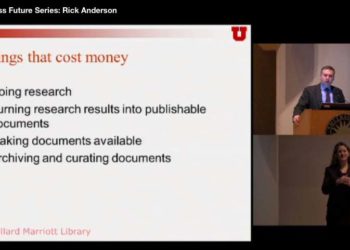
This past October, I was invited to give a talk at a university as part of its library’s Open Access Week programming. During the course of my presentation, I mentioned the fact that within the community of people who consider themselves supporters and advocates of OA, there is significant disagreement about the definition of OA — and also about what the ultimate goals of the movement should be, however OA itself may be defined. After my presentation there was a panel discussion, which opened with one of the panelists taking strong exception to a number of things I had said, but particularly to my assertion that there is a meaningful diversity of goals and definitions in the OA movement. “Look,” he said, “everyone in the OA movement wants all scholarship to be freely available. We all agree on that.”
The problem, of course, is that this simply isn’t true. Not only is there wide disagreement as to what “freely available” really means, but not everyone in the OA movement even agrees that all scholarship must be freely available, or how quickly it should be made freely available, or what mechanisms are appropriate for making it that way. Since the fact of this ideological diversity doesn’t seem to be self-evident, I thought it might be helpful to lay out some of the evidence for it here, and then briefly raise some of the important questions and issues it suggests.
(By the way, attentive readers may be getting the nagging sense that this particular issue has been discussed earlier here in the Kitchen. It was, by me, just over two years ago. At that time I suggested that there was a “hardening consensus” in the OA movement regarding the definition of “true” OA. In 2014 I believed that. Today I’m not so sure, for the reasons I’ll now lay out.)
Diversity of Definitions
- According to the Berlin Declaration’s “Definition of an Open Access Contribution,” OA means that access to the content is free and hosted in a repository maintained by an institution dedicated to promoting OA, though the declaration does not require that either deposit or public access be immediate upon publication. Under this definition most (but not all) copyright prerogatives are assigned to the public — though the qualifier “… for any responsible purpose” is rather interesting in its vagueness. This definition says explicitly that OA principles should be applied to all products of “scientific knowledge” and “cultural heritage,” indicating that they apply as much in the humanities as in the sciences. (IFLA has adopted the same definition.)
- The Bethesda Statement provides a similar definition, with an important difference: Bethesda says that OA requires immediate deposit, though it too leaves open the question of embargoes on access.
- According to the Budapest Initiative, access must be free, and virtually all copyright prerogatives are assigned to the public — the exceptions being those prerogatives that “give authors control over the integrity of their work” and the “right to be properly acknowledged and cited.” With this definition there is no required timeframe for either deposit or access, although the statement includes a recommendation that deposit be no later than the date of publication. Unlike both the Bethesda Statement and the Berlin Declaration, the Budapest Initiative leaves open the question of what constitutes an acceptable repository, providing only broad guidelines. Interestingly (and unlike the Berlin definition), the Budapest statement seems to focus excusively on “peer-reviewed journal literature,” suggesting that OA has less applicability to other manifestations of scholarship.
- SPARC and SPARC Europe both define OA as immediate free access to content, with all copyright prerogatives assigned to the general public. (As the SPARC statement puts it, “SPARC considers the terms outlined by the Creative Commons Attribution-Only license [CC-BY] to be the standard terms for Open Access.”) In a significant departure from the three definitions offered above, however, the SPARC definition does not make deposit in any kind of repository an essential element of OA. Digital repositories are cited as only one of several “primary mechanisms” for providing OA.
- In contrast to SPARC, the Directory of Open Access Journals (DOAJ) does not consider CC BY to be a defining feature of OA. It features in its directory many journals that publish under more restrictive licenses. Since a listing in the DOAJ is widely regarded as a marker of legitimacy in OA publishing, this represents a significant discrepancy of definition with real implications for the marketplace. The Open Access Scholarly Publishers Association (OASPA) also allows its members to use CC licenses more restrictive than CC BY, although it strongly encourages them to use CC BY.
- The Ghent Declaration provides a definition similar to the one SPARC uses, but it too is less strict regarding reuse rights. In fact, its language regarding reuse rights—“without restrictions on use commonly imposed by publisher copyright agreements”—is notable for its vagueness.
- To add to the confusion, there’s the problem of defining “OA publishing,” as distinct from OA itself. This definition matters because it determines whether or not a particular publisher or journal is included in influential indices like the DOAJ and SHERPA/RoMEO and whether its authors will be able to get local subsidies for article-processing charges. The most common faultline in this regard is that between “hybrid” and fully-OA journals. Hybrid journals (which charge subscription fees but include some OA articles) are not considered to be true OA publications by DOAJ and are thus excluded, and authors who wish to publish in hybrid journals cannot get financial support from the libraries at, for example, any of the signatories to the Compact for Open-Access Publishing Equity (COPE), including Harvard, Dartmouth, Duke, Calgary, Emory, Barcelona, Simon Fraser, and Karlsruhe.
Implications
So why is this worth talking about? Does it matter that there are competing (or at least different) definitions of OA out there?
I believe it does, for several reasons.
For one thing, it’s important to note that there’s a big difference between identifying different varieties of OA (such as “libre” and “gratis”) and proposing mutually incompatible definitions of OA. Definitions compete when they are mutually exclusive: in other words, a definition that says OA is only legitimate when it provides immediate access isn’t compatible with a definition that says embargoes are okay, and a definition that requires the granting of all copyright prerogatives to the public isn’t compatible with one that allows for CC-BY-NC licensing. The “gratis” and “libre” categories of OA can logically coexist, whereas the “no embargo” and the “some embargo” definitions of OA negate each other. This fact has serious implications for the formation and implementation of initiatives at any level beyond that of the individual institution.
Does it matter that there are competing (or at least different) definitions of OA out there?
For another thing, it matters very much whether two people who are talking about “OA” can reasonably assume that they’re referring to the same thing. As things stand now, they can’t. One person who asks another to join in an effort to promote OA may be asking that person to promote the mandatory immediate deposit of final approved manuscripts without embargo and under CC BY terms, while the other person might reasonably think he’s being encouraged to promote the publication of OA articles in either hybrid or fully-OA journals, with or without CC licensing provisions.
Furthermore, disagreement as to the definition of OA publishing leads to inconsistent and misleading data about the industry. For example, one frequent topic of study and discussion among observers of the scholarly-communication ecosystem is the growth of OA over time. How do you measure that without a more or less universally-understood definition of OA? Another topic of study is the prevalence of articles produced by APC-funded OA journals relative to those produced by institutionally-subsidized OA journals. But without broadly agreed-upon standards as to what constitutes an OA journal, there’s no hope of gathering usefully accurate data on these important and controversial topics. If two people try to measure the prevalence of author-funded OA publishing, but one of them excludes hybrid journals from her analysis (because hybrid journals don’t represent real “OA publishing”), their data will be wildly incommensurate.
Last of all, a lack of certainty as to what constitutes legitimate OA publishing leads to frustration when OA publishers want to make themselves discoverable using standard industry tools, and when interested authors and others want to identify OA publishers with which to place their work. As mentioned above, for example, hybrid journals are excluded from DOAJ but included in SHERPA/RoMEO. CC BY is considered an essential element of OA by publishers like PLOS, but isn’t considered an essential element of OA by directories like the DOAJ. The rules aren’t consistent, and this can only lead to frustration and confusion for everyone involved.
Of course, the only way to settle questions about the “true” definition of OA would be to settle on at least a working consensus within the OA movement about what it’s trying to accomplish. And this brings us to the issue of competing visions for the future of scholarly communication, which will be the topic of my next posting.
(By the way, at his always-useful Open and Shut blog, Richard Poynder has recently been thinking about similar issues.)
Discussion
26 Thoughts on "Diversity in the Open Access Movement, Part 1: Differing Definitions"
I too addressed this issue, back in 2013: https://scholarlykitchen.sspnet.org/2013/11/11/open-access-on-the-sea-of-confusion/. But on reflection I think it is characteristic of social and political movements generally. There are varying degrees of radicalism, as it were, some mild, some wild. There is no specific goal state, just movement in a direction. This is a normal revolution.
That’s why I think, it’s important to establish clear OA strategies (how to achieve Open Access) instead of setting up new unspeficic OA policies.
To complicate matters, someone has decided that “diversity” is falling out of style these days and the new buzzword is “inclusive” (even Oprah is on-board with the new lingo). Diversity is about quantity. Inclusion is about quality. http://www.americanbar.org/publications/gpsolo_ereport/2012/june_2012/diversity_invited_party_inclusion_asked_dance.html
about my earlier comment on the banner not being kitcheny: is it an image of rosemary on a chopping board, with a yellow squash to the left? It’s pale, and I first took it for a forest. Apologies.
Patricia
A useful discussion, but I’ll take issue with one statement: “If two people try to measure the prevalence of author-funded OA publishing, but one of them excludes hybrid journals from her analysis (because hybrid journals don’t represent real “OA publishing”), their data will be wildly incommensurate.” Well…the best study (only study?) I’ve seen suggests that, at least as of 2013, only about 2% of OA articles are in “hybrid” journals. Sure, there are thousands of such journals, but precious few overpriced papers. I discuss this a bit here: http://walt.lishost.org/2017/01/all-of-gold-oa/
Hi, Walt —
In the sentence you quoted, I’m talking about “measuring the prevalence of author-funded OA publishing.” What I’m really talking about there is counting journals, rather than counting articles. If someone wants to count “OA journals” and excludes hybrids, her numbers will be wildly incommensurate with the data found by someone else who includes hybrid journals.
That really is a definitional issue. I don’t believe “hybrids” are OA journals; neither does DOAJ. Elsevier and others making essentially *all* journals hybrid obscures the situation, mostly making it easy to question any numbers about the field
Conversely, if one excludes the many thousands of OA journals on Beall’s lists, which are rapidly increasing in number and publishing hundreds of thousands of articles a year, one will miss an important OA growth sector. In Beall’s January 2017 list the number of standalone OA journals increased by about 50% while the number of multi-journal publishers increased by about 25%, from his prior list. I think these Beall’s list low cost journals dwarf the hybrids when it comes to OA publishing, but many exclude them because DOAJ does not recognize them as legitimate journals, even though they are publishing legitimate science. Content is not among the criteria for inclusion. Thus the OA confusion is widening, not converging.
David–see the link in my first comment, or just go to Cites & Insights 17:1, a thorough quantitative study of “gray OA” from 2011 through the first half of 2016, using Beall’s lists for the only things they were valuable for: as reasonably comprehensive non-DOAJ gold OA directories. http://citesandinsights.info/civ17i1.pdf
After 15 years of confusion and debate, I think the publishing community must be enjoying the library communities attempt to get their act together. But consider this after 15 years the top 20 STM publishers still get 95% of their revenue from paid subscriptions and with the top five publishers it is 98%. Librarians spend an enormous amount of time on pushing the OA agenda, but the original target is still a very long way off.
It seems to me that OA advocates have no idea what the word free means. To them it means free to read at will. Of course, I am a OA education advocate and strongly believe that Professor should not be paid. After all most receive some sort of funding for their education. But, that idea just doesn’t seem to fly!
Hi Rick, I completely concur that varying definitions make statistics difficult. Could you clarify your statement that “hybrid journals are excluded from DOAJ but included in SHERPA/RoMEO”? On the face of it this doesn’t seem like a conflict to me, since DOAJ is a directory of open access journals while SHERPA/RoMEO summarizes publisher copyright and self-archiving policies for any type of journal.
Diversity eh? Take a look at the monochromatic faces on the top right hand side.
Hi G,
Diversity of representation has been a major focus at the SSP as well as here in the Kitchen. Over the last few years we’ve worked to have a better gender balance, which I think we’ve achieved. But you’re right, public representation of our industry is overwhelmingly western and white (as evidenced by the attendees at any major publishing meeting). This is something we’re working with the SSP on, seeking out a more diverse group of voices, particularly publishers representing the global south. We have a few strategies that will go into effect in the coming months, so expect to see a better job on our part soon. As always, suggestions on how we could do a better job are appreciated, feel free to email us at scholarlykitchen@sspnet.org
Political diversity would also be nice. I frequently feel like I am the only conservative in the Kitchen.
An interesting read Rick. One thing I am not clear about is what you believe has changed since 2014 in terms of a consensus on a definition of “true OA”. Has not the situation you describe above ever been thus?
I think this is a really important discussion, and I’m glad you’ve raised the subject of the different and sometimes competing definitions and approaches to producing or defining OA, Rick. I can appreciate the difficulties you point out that are precipitated by these differences, namely, the frustrations likely encountered in gathering homologous data for analysis and the way it complicates industry standards of discoverability. However, I think that there is also another constructive way (I don’t say “positive” because I don’t see yours as necessarily negative) to see the lack of consensus about what constitutes OA publications and publishing. Though OA has been a hotly debated publishing topic for over twenty years, we are still in frontier terrain–it’s no longer the Wild West, but there is still no single set of laws or infrastructure, no one sustainable business model that addresses all or at least most of the reasons that stakeholders want OA. I would argue that the diversity of definitions, inability to do big data analysis, and the lack of a one-stop-shop path to discovery represents the still-experimental and exploratory status of OA in the industry. That’s exciting, even though, yes, it makes analysis of current and past (especially failed but useful to study) instantiations of OA practices and approaches a bit of a challenge.
Thanks for the articles.



